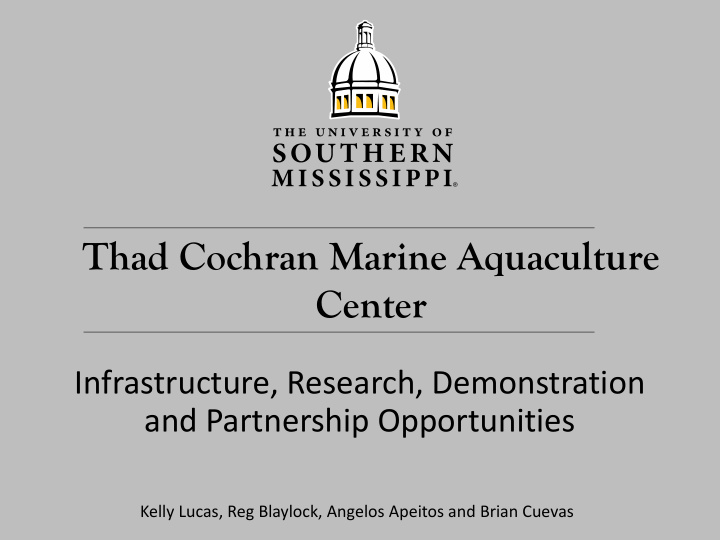



Thad Cochran Marine Aquaculture Center Infrastructure, Research, Demonstration and Partnership Opportunities Kelly Lucas, Reg Blaylock, Angelos Apeitos and Brian Cuevas
Overview • Location • Infrastructure • Research and Development • Species • Partnerships, Services and Agreements
We work with industry, government and non-profit organizations to alleviate the TCMAC bottlenecks that constrains the production of marine species.
Located: Central Gulf of Mexico
Ocean Springs Research Sites
Distr trib ibuted F Faci cilit itie ies a and R Res esources USM Main Campus
Faci ciliti ties • 13 Buildings • 9,300 m 2 • 4,600 m 2 • culture space for animals and live feeds • 930 m 2 • Experimental space • isolated and replicated disease, nutrition, and genetics/reproductive physiology research • contains isolated small-, medium-, and large-scale systems with single-pass climate control
Syst ystems • RAS technology • Artificial seawater or raw seawater • Filtration and water quality • Propeller-washed bead filters • Moving bed bioreactors • Protein fractionators (with ozone) • Heat pumps • Oxygen cones (5,000-gal liquid Oxygen backup) • Biosecure • Climate controlled • Customizable tanks and systems • Generator backup • Gated/ Secure facility
Finfi fish sh Brood Sys Syste tems • 5 areas for brood holding and maturation • 571,000 L tank space • 3 – 6 m diameter tanks • Photo-thermal control • Dedicated generator and oxygen backup • Remote monitoring
Incubation & Hatching Systems • 3 systems for egg incubation and hatching • 3,720 L tank volume • RAS Systems • Thermally controlled
Live Feeds Systems • Copepods • 148,000 L of culture volume available • 20 million Nauoplii produced daily • Rotifers • Static water systems • 100 to 200 L tanks • 2200 L culture volume available • 800 million to 1.2 billion rotifers produced daily • Artemia • 400 L static systems • 3200 L volume available • 800 million Instar 2 produced daily
Algae • Systems • Semi-continuously operated photobioreactors • PureBiomass PBR • 1,375 L and 250 L • Industrial Plankton • 1,000 L • Hanging bag system • Production Capability • Productivity: 0.20g L -1 day -1 • Current • Yield 240 g day -1 • Yr. 2021 • 1,100 g day -1 • Species • Chaetoceros calcitrans, Chaetoceros muelleri, Nannochloropsis oculate, Pavlova lutheri, Rhodomonas salina, Tetraselmis sp., Thalassiosira weissflogii, Tisochrysis lutea.
Larval Rearing Systems • 7 areas available for rearing larvae • 120,000 L culture volume • RAS & static systems • 400 – 4000 L tanks • FRP or HDPE • Photo-thermal control
Nursery Systems • 2-3 systems available • 92,000 L culture volume • 1.5 to 5.5 m diameter tanks • Thermal control • Operated at a 40 kg/m 3 , designed for higher loads
Growo wout Syst ystems • 8 systems available • 1.1 million L available culture volume • 1.5 – 5.5m tanks • Thermally controlled
Oyster Hatchery • Artificial Seawater • Recirculating closed systems • Temperature control • Volume ASW • Current: 87,000 L • YR 2021: 450,000 L • Capacity • Current: 300 Million larvae • YR 2021: 5 Billion larvae
• Aquatic Health • Genetics • Larviculture Research and • Reproductive Physiology Development • Live Feeds • Recirculating Aquaculture Systems Design • Nearshore and Offshore Aquaculture
Species • Current • Spotted sea trout ( Cynoscion nebulosus ) • Tripletail ( Lobotes surinamensis ) • Blue crab ( Callinectes sapidus ) • Oyster ( Crassostrea virginica ) • Collecting in 2020 • Red drum ( Sciaenops ocellatus ) • Gray snapper ( Lutjanus griseus ) • Previous • Red snapper ( Lutjanus campechanus ) • Atlantic croaker ( Micropogonias undulates ) • Striped bass ( Morone saxatilis ) • Cobia ( Rachycentron canadum ) • Marine shrimp ( Litopenaeus vannamei ) • Pompano ( Trachinotus carolinus )
Foster aquaculture technology development and commercialization Partnership Agreements Licensing Agreements Industry Partnership Services Develop Strategic Agreement Partnerships Confidentiality and Material Transfer Agreements Technology is transferred Sponsored Research Research Subaward to Industry collaborator Available Services: through Option, Licensing • Analytical and Biological Testing and Joint Partnership • Research and Development Lease Space Agreement • Sponsored Research • Technology License • Aquaculture Consulting
Bridging the innovation gap for early stage aquaculture companies to increase speed to market and revenue growth
Kelly Lucas, PhD. Director Thad Cochran Marine Aquaculture Center School of Ocean Science and Engineering The University of Southern Mississippi 228-818-8028 Kelly.lucas@usm.edu
Recommend
More recommend